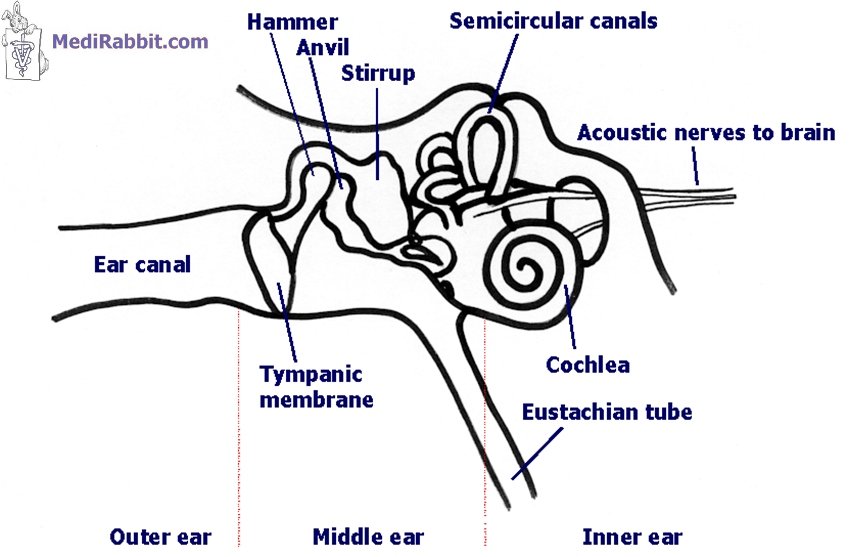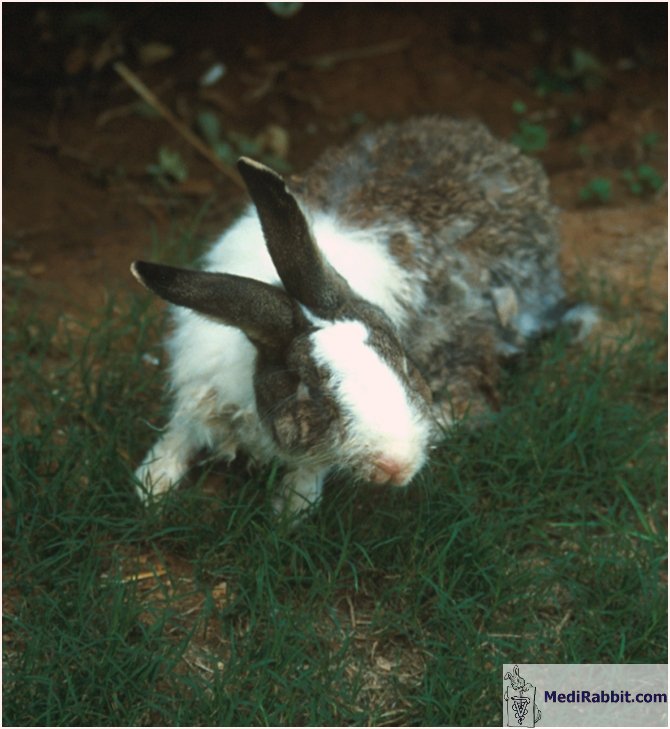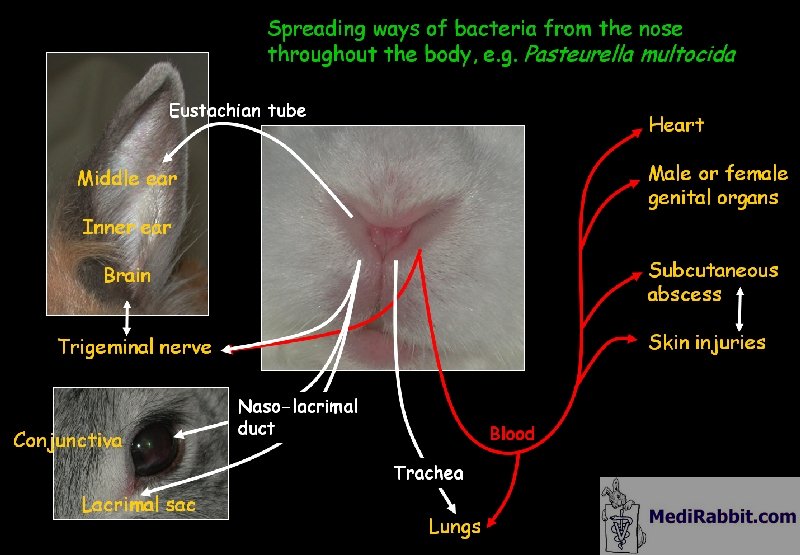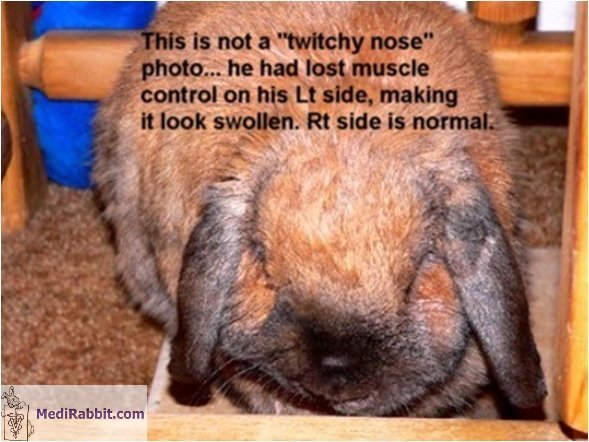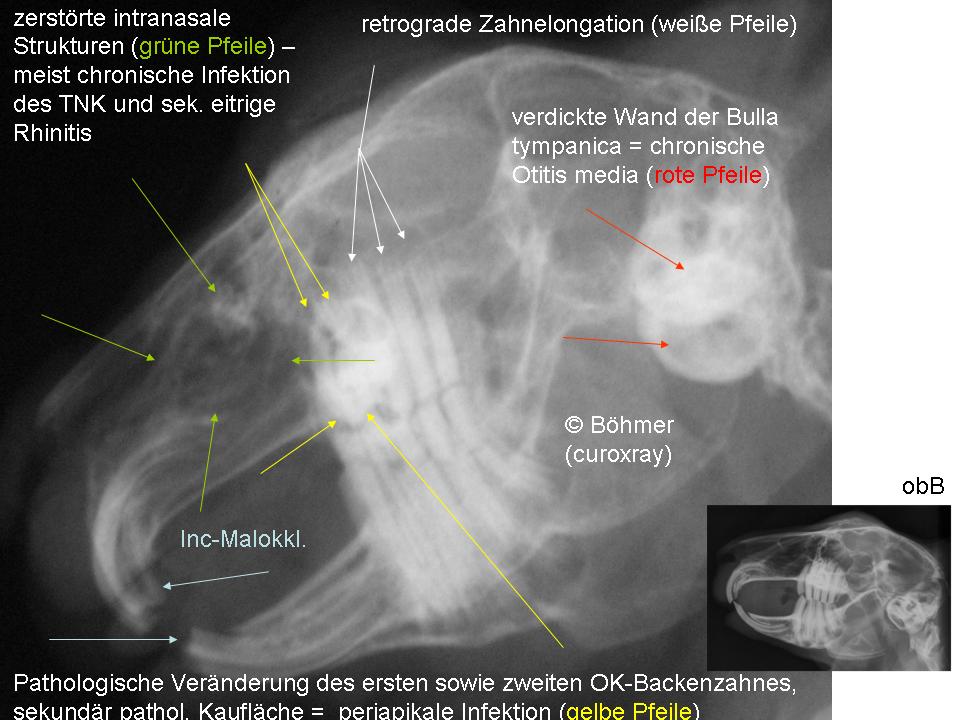Middle and
inner ear (otitis media and interna)
Esther van Praag, Ph.D.
|
MediRabbit.com is
funded solely by the generosity of donors. Every
donation, no matter what the size, is appreciated and will aid in the continuing
research of medical care and health of rabbits. Thank you |
|
Otitis media
and interna, Latin names for inflammation of the
ear chambers located behind the tympanic membrane (ear drum), involve about
50% of all cases of acute vestibular disease. The middle ear is the region
located directly behind the tympanic membrane (eardrum). It is made of the
different bones and nerves responsible for the diffusion of the sound coming
from the outer ear to the brain. The middle ear is connected to the nasal
cavity by the Eustachian tube, opening that enables the adjustment of the air
pressure inside the middle ear. It is responsible for balance.
MediRabbit
Mammalian inner ear
Otitis media, or middle ear
infection, is typically located behind the eardrum. The presence of bacteria,
fungi, yeast, or parasites triggers the production of fluid and pus, which results in
inflammation and pain, and may lead to the loss of hearing.
When the infection is severe,
rupture of the tympanic membrane can occur. The pus contained in the middle
ear will flow into the ear canal and the infection can spread to the outer
ear. The infection can also spread from the middle ear to the inner ear
(otitis interna or labyrinthitis). This development of the disease is marked
by head-tilt, and ataxia (lack of balance). Pasteurella multocida, a natural
host of the nasal cavity of rabbits, is often associated with middle and
inner ear infection. Healthy rabbits can be carriers of this bacterium,
without showing clinical signs. The development of the disease depends on the
general resistance of the host and the virulence of the Pasteurella
sp. strain. The bacterium is believed to migrate from the nasal cavity to the
middle ear along the Eustachian tube or mandibular molar root abscess with
exposure to the Eustachian tube. Staphylococcus aureus is
considered an opportunistic pathogen of the nasopharyngal cavity of rabbits.
Its presence in the ear can lead to severe middle or inner ear infection. The
Staphylococcus aureus bacterium can present resistance to one or more
antibiotics. Further
bacteria known to cause inner ear infection include Streptococcus sp.,
Escherichia coli, Enterococcus sp, Proteus sp., Pseudomonas
sp.. Sporadic cases of yeast infection, e.g. Candida sp. or Pityrosporum
sp., are found in rabbits. Fungal infection, e.g. Cryptococcus sp., is
rare.
MediRabbit
Spread
pathways of bacteria from the nasal cavity to the middle and inner ear
Clinical
signs
Clinical signs for otitis
media can be absent. More often, they cannot be distinguished from an external
ear infection: shaking of ears, scratching with paws, rubbing, anorexia,
depression and pain. Discharge is observed in the external ear canal if the
eardrum has rupture under the internal pressure caused by the infection. Middle ear infection is characterized by head shaking and drooping of the ear. Facial paralysis is possible when there is swelling and compression of the facial nerve. Rabbits may hear less well, due to pus in this part of the ear. The condition is painful. Inner ear infection is accompanied by ataxia (circling, rolling
stumbling), leaning to one side and head-tilt. Some rabbit sway their head from side to side. This
is caused by the pressure of the infected tissue and inflammation of
surrounding tissues leading to the compression of nerves
passing through the vestibular region of the brain.
Kim Chilson
Rabbit suffering from facial paralysis: a front view from the face shows asymmetry of the face. This is caused by the dropping of the lip on the paralyzed side Appearance of nystagmus
(involuntary rhythmic eye movement) is observed when treatment is late or
inappropriate. When observed, it can be indicative of inner ear infection or E. cuniculi. Depending on the location
of the damage, differences of eye movement are, indeed, observed: -
Bacterial infection of the inner ear generally leads
to peripheral vestibular disease. This is characterized by horizontal and
rotary nystagmus, but never vertical nystagmus. -
E. cuniculi is generally related to central vestibular disease,
which shows typically vertical and positional nystagmus, more rarely
horizontal nystagmus. The vertical nystagmus is the one mainly observed in E.
cuniculi suffering rabbits that do not suffer from secondary inner ear
infections. -
Rotary nystagmus (in vertical and horizontal
directions). This relates to lesions of the cerebellum, the brainstem or the
vestibular connections; causes can be the presence of a tumor or a bacterial
infection (encephalitis), to name the main ones. The direction of repetitious involuntary eye
movement should not be a basis for a final
diagnosis between the two disorders. Nystagmus is a clinical
feature of various diseases, including metabolic disorders, eye disorder
(glaucoma, cataract, retina problems, and albinism), nutritional
deficiencies (e.g. magnesium, thiamin, medication (e.g. barbiturates), the
presence of brain lesions, or trauma.
MediRabbit.com
Middle ear infection may be accompanied
by continuous horizontal or rotary nystagmus, while nystagmus caused by E.
cuniculi is usually vertical, horizontal or positional
Renee
Brennan
Video of Rudy, a rabbit presenting clinical signs of encephalitozoonosis: severe involuntary head tilt and rhythmic horizontal movement of the eyes
Diagnosis
It is
important to differentiate ear infection from other causes of vestibular
diseases. See: Head tilt and their various causes. Otitis media is visible on X-rays, changes on the level of the bullae,
on the contrary of otitis interna and E.
cuniculi lesions. Changes of the soft tissue density are observed in the
middle ear, with appearance of an opaque grayish mass. It is sometimes
accompanied by sclerosis and bone proliferation, which may reach as far as
the temporal bone or the temporo-mandibular joint.
X-ray can, furthermore, help rule out dental problems or E. cuniculi.
Dr. Estella Böhmer, curo–X-ray
Chronic middle ear infection can be
seen on X-rays, with a thickening of the tympanic wall (red arrows). This
rabbit also suffers dental problems: malocclusion of the incisors,
retrograde elongation of the maxillary cheek teeth (white arrows), a
pathological modification of the first and second maxillary cheek teeth and
infection surrounding their roots (periapical infection - yellow arrow).
The x-ray also shows that the structure of the nasal cavity has been
destroyed (green arrow). This results often from chronic infection of the
nasolacrymal duct or secondary rhinitis accompanied by nasal secretions.
If
discharge is present in the outer ear, the presence of bacteria, yeast or
fungi should be determined by means of a culture, followed by a sensitivity culture
in order to determine the most effective antibiotic or antifungal treatment. Cytological
methods will help determine the presence of bacteria, yeast, fungi and
certain types of cancer. A
complete blood count (CBC) and biochemistry panel can help determine the
presence of an infection or E. cuniculi, with neutrophilia or changes
in values related to the kidney function (BUN, creatinine) respectively. Serological
tests help determine exposure to E. cuniculi or Pasteurella sp.
during its life. A high titer is linked to an active infection. These tests
are indicative only. Treatment
The
antibiotic treatment should be based on the result of the sensitivity
culture. This is not always possible; in that case, antibiotics known to pass
the blood-brain barrier must be administrated. Chloramphenicol
and penicillin (bicillin) antibiotics pass the
blood-brain barrier and have successfully treated middle or inner ear
infection in rabbits. Trimethoprim sulfate is sometimes advised, but appears
to bring poor improvement in rabbits. This could relate to the fact that
half-life of this drug is about 40 min in rabbits. Ciprofloxacin has been
successful to treat a case of inner ear infection in a dwarf rabbit. Combined
antibiotic therapies can be administered, such as
enrofloxacin/chloramphenicol or marbofloxacin/penicillin. The treatment
must be aggressive and long, a minimum of 4 to 6 weeks, or continued another
2 weeks after full disappearance of the symptoms. If no improvement is observed
after 14 days, it is possible to switch to another antibiotic. In order to
minimize the appearance of resistance in the pathogenic bacteria, it is best
to administrate a cocktail including the old antibiotic and the new one. An otoscopic examination is necessary to determine if the
eardrum is ruptured. If this is the case, antibiotic-containing eardrops will
lead to ototoxicity. The consequence is permanent deafness, loss of balance
or death. A safe alternative to remove pus and debris is to wash out the
outer and middle ear with a saline solution. The
antibiotic therapy should be accompanied by NSAIDS (non-steroidal
anti-inflammatory drugs) pain medication. Meloxicam can be used over a longer
period of time, without reported side effects in rabbits. The use of glucocorticosteroids in the treatment of ear infection is
controversial. They are advisable during the first days of treatment, in
order to reduce the inflammation, but their use of should not extent over 5
days, due to their immunodepressive properties. The
administration of meclizine, a motion sickness drug, is advisable in case of otitis
interna. If the rabbit
has trouble eating and drinking, force-feeding and administration of SC
fluids are necessary. If the middle
ear or the nerves are damaged, deafness or head-tilt is irreversible. Prognosis of
surgical drainage, e.g. bulla osteotomy, is poor and is accompanied by
post-operative complications in rabbits. It should be used in cases of severe
infection of the middle or inner ear, when antibiotics fail to keep the
situation under control.
Kei Rivers
Holly,
the rabbit of Kei Rivers (New-Zealand).
This video is a testimony that a rabbit suffering from head-tilt can continue to enjoy a good quality of life, without need to pts. Acknowledgement
My
deepest gratitude to Dr. Zahi Aizenberg, (The Koret School for Veterinary Studies, The Hebrew
University of Jerusalem, Bet-Dagan, Israel) and to Dr. Estella Böhmer (Chirurgische u. Gynäkologische Kleintierklinik,
Ludwig-Maximilians-Universität
München, Germany) for the permission to use their
pictures. Many
thanks also to Renee Brennan for sharing the video of her head-tilted rabbit
Rudy and to Kei Rivers for sharing her video of Holly. Further information
Bjotvedt G, Geib LW. Otitis media associated with Staphylococcus
epidermidis and Psoroptes cuniculi in a rabbit. Vet Med Small Anim Clin. 1981; 76(7):1015-6. Flatt RE, Deyoung DW, Hogle
RM. Suppurative otitis media in the rabbit:
prevalence, pathology, and microbiology. Lab Anim
Sci. 1977; 27(3):343-7. Fox RR, Norberg RF, Myers DD. The
relationship of Pasteurella multocida to otitis media in the domestic
rabbit (Oryctolagus cuniculus). Lab Anim
Sci. 1971; 21(1):45-8. Harcourt-Brown F. Rabbit Medicine and Surgery, Oxford, UK:
Butterworth-Heinemann 2001, 192 pages. Hillyer EV, Quesenberry QE. Ferrets, Rabbits, and Rodents: Clinical
Medicine and Surgery New York: WB Saunders Co.,1997,
432 pages. Kunstyr I, Naumann S. Head tilt in rabbits caused by pasteurellosis and encephalitozoonosis.
Lab Anim. 1985; 19(3):208-13. Ladefoged O. The
absorption half-life, volume of distribution and elimination half-life of
trimethoprim after peroral administration to
febrile rabbits. Zentralbl Veterinarmed
A. 1979; 26(7):580-6. Murray KA, Hobbs BA, Griffith JW. Acute meningoencephalomyelitis
in a rabbit infected with Pasteurella multocida. Lab Anim Sci. 1985; 35(2):169-71. Richardson V. Rabbits: Health, Husbandry and Disease, Blackwell
Science Inc, 2000, 178 pages. Snyder SB, Fox JG, Campbell LH, Soave OA. Disseminated staphylococcal
disease in laboratory rabbits (Oryctolagus cuniculus). Lab Anim Sci. 1976; 26(1):86-8. Snyder SB, Fox JG, Soave OA. Subclinical otitis media associated with Pasteurella
multocida infections in New Zealand white rabbits (Oryctolagus
cuniculus). Lab Anim Sci. 1973; 23(2):270-2. |
e-mail: info@medirabbit.com



